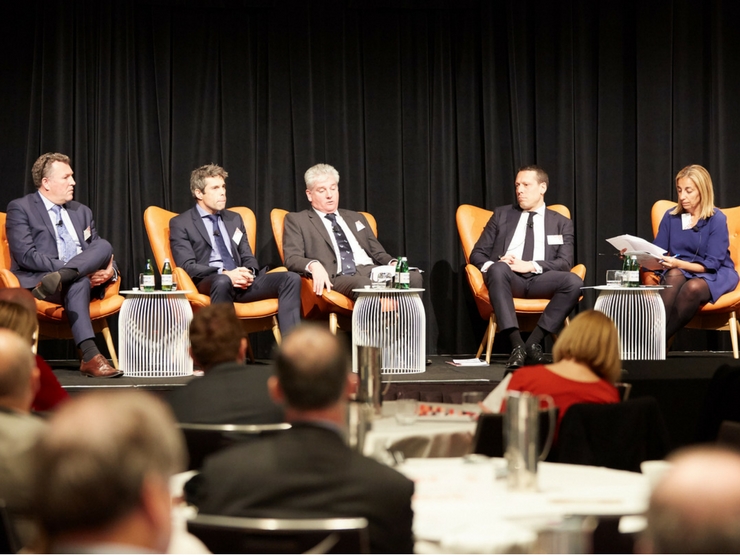Total spending grew 0.9% in June.


A panel of fund managers and NAB’s Connie Sokaris discussed the vexing issue of how to create income in a low interest environment at the KangaNews-NAB Fixed Income Beyond the Institutional Sector Summit.

What risks should be taken in a low-interest-rate environment?
Panel participants
Avi Anger, Fund Manager, Charter Hall Group
Nick Bishop, Head of Australasian Fixed Income, Aberdeen Asset Management
Richard Murphy, CEO, Australian Corporate Bond Company
Cameron Rae, MD, Laminar Capital
Moderator: Connie Sokaris, General Manager, Resources, Infrastructure and Government, NAB
How do investors manage climbing rates creating volatility in what’s expected to be a stable asset class?
Rae: The term ‘fixed income’ covers a broad sector of the asset class but not everything is fixed. In fact, a big portion of the market is in securities that offer a floating rate. Ninety-five per cent of what we do with our clients is floating. The rate resets every 90 days or, in the residential mortgage backed space, every 30 days. With a bond, there’s the credit risk and the interest rate risk. By going floating you can take the latter off the table.
Bishop: Floating rates can insulate you from interest rate rises and are definitely useful. That said, if you want floating exposure to blue-chip Aussie corporates, good luck finding those. Plus, many of those who invest in bonds want them to behave like bonds. The blessing and curse of long-term fixed interest is that when the yields go up, when the rates go up, it has a marked market impact. But when equities plummet then high-quality bond yields rally. If you want income and capital stability, then have a look at floaters. If you want your fixed income investments to act like an insurance policy then a floating rate isn’t for you.
What do fund managers offer investors that they can’t do themselves?
Bishop: Someone who’s been listening to the discussions about all the investment options being canvassed at this event might say, “That all sounds complicated, can you take can take care of it for me?” Well, that’s what an institutional asset manager does. It analyses the thousands of companies that issue bonds and applies intellectual horsepower to assessing investment opportunities. We think about risk mitigation and the overall quality of the investment rather than going, “Oh, that’s the highest-yielding bond, we’ll buy that one.”
Rae: We take a similar approach. We take institutional expertise and overlay that on the bonds we’re buying on our own balance sheet. But we give investors direct access to those bonds, rather than them having to go through a fund.
Murphy: We’ve opened up the corporate bond market to all investors and now have over 50 XTBs [exchange-traded bonds] available on the ASX. Thanks to us, if you’re sitting out in Wagga Wagga, you can use a platform like nabtrade to buy XTBs.
Anger: We do due diligence on the financials of tenants. We get investment-grade tenants, such as Coles, Westpac and the Australian Government, to commit to long-term leases. That allows us to deliver a reliable return for investors. It’d be hard for an investor to replicate what we do in terms of them getting exposure to institutional quality property and attracting investment grade tenants, who prefer to deal with sophisticated landlords. REITs are a great example of how you can take conservative, illiquid assets and put them in a digestible, digitised form. Plus, you don’t need to have sophisticated investor status to buy them.
How do you justify the fees you charge, particularly in a low-interest rate environment?
Bishop: Aberdeen Asset Management has been around for decades in all sorts of interest rate environments. Throughout that time, people have always wanted more for less; that’s a natural human trait. We’re constantly looking for efficiencies so we can pass on lower costs to consumers. We’ve lowered fees over the last few decades on most of our unit trusts. It’s a matter of convincing investors that they’re getting fair value and that it’s worth adding a little premium for professional management.
There’s a lot of audience interest in bank hybrids. Are they something investors should consider?
Murphy: I don’t have a problem with sophisticated investors exploring them. What worries me is that there are advisers out there who don’t know what they’re talking about. They’re going to the 11 million investors in Australia and saying, “Hey, buy this instead of a term deposit, you’ll get 6 per cent instead of 2 per cent, it’s only a little more risk”. I find that utterly misleading, letting mum and dad investors think it’s just the listed version of a senior bond. ASIC should step up and do something about it.
© National Australia Bank Limited. ABN 12 004 044 937 AFSL and Australian Credit Licence 230686.